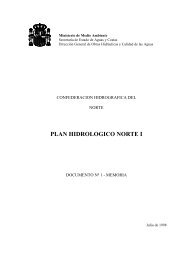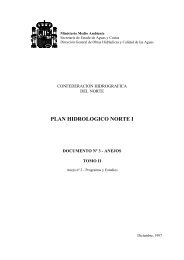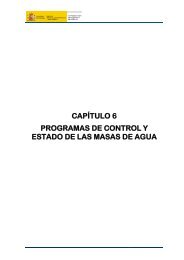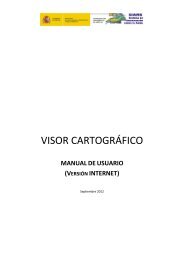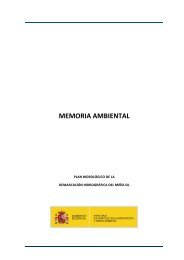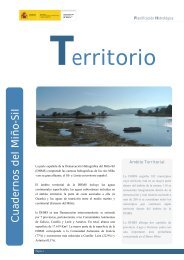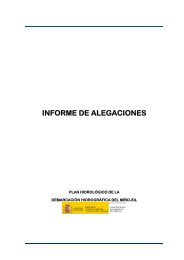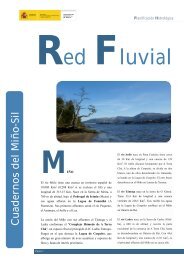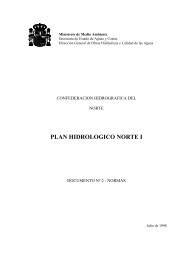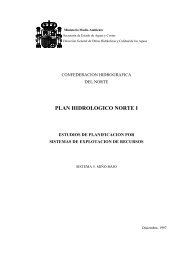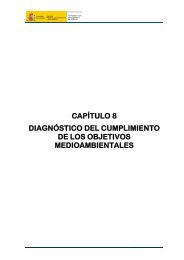Tipología de ríos y conformidad con las comunidades biológicas en ...
Tipología de ríos y conformidad con las comunidades biológicas en ...
Tipología de ríos y conformidad con las comunidades biológicas en ...
You also want an ePaper? Increase the reach of your titles
YUMPU automatically turns print PDFs into web optimized ePapers that Google loves.
la comarca <strong>de</strong> Gijón <strong>en</strong> el Principado <strong>de</strong> Asturias) y los <strong>ríos</strong> pequeños <strong>de</strong> montaña (tipo 5), muy<br />
abundantes <strong>en</strong> la Cordillera Cantábrica y estribaciones. Cabe <strong>de</strong>stacar que los <strong>ríos</strong> mixto‐<br />
calcáreos <strong>de</strong> montaña (Tabla 14), para diatomeas el tipo 1, son un tipo poco abundante que está<br />
restringido al macizo c<strong>en</strong>tral <strong>de</strong> los Picos <strong>de</strong> Europa. Por su parte, los ejes principales <strong>de</strong><br />
invertebrados (tipo 1) son también muy escasos, localizándose prácticam<strong>en</strong>te sólo <strong>en</strong> el<br />
Principado <strong>de</strong> Asturias.<br />
Tipos diatomeas<br />
Cantábrico<br />
1. Ríos mixto‐<br />
calcáreos <strong>de</strong><br />
montaña<br />
1. Ejes<br />
principales<br />
2. Ríos mixto‐<br />
calcáreos<br />
3. Ríos mixto‐<br />
silíceos<br />
Tabla 14. Correspon<strong>de</strong>ncia <strong>en</strong>tre los tipos <strong>de</strong> asociaciones <strong>biológicas</strong> <strong>de</strong> invertebrados y diatomeas. Se<br />
muestra el porc<strong>en</strong>taje <strong>de</strong> tramos fluviales para cada tipo <strong>en</strong> la Demarcación Hidrográfica <strong>de</strong>l<br />
Cantábrico.<br />
Tabla 15.1. Distribución por comunida<strong>de</strong>s autónomas <strong>de</strong>l porc<strong>en</strong>taje <strong>de</strong> tramos fluviales<br />
correspondi<strong>en</strong>tes a cada tipo <strong>de</strong> asociación biológica <strong>de</strong> invertebrados.<br />
Tabla 15.2. Distribución por comunida<strong>de</strong>s autónomas <strong>de</strong>l porc<strong>en</strong>taje <strong>de</strong> tramos fluviales<br />
correspondi<strong>en</strong>tes a cada tipo <strong>de</strong> asociación biológica <strong>de</strong> diatomeas.<br />
23<br />
4. Ríos mixtos<br />
<strong>de</strong> llanura<br />
5. Ríos pequeños<br />
<strong>de</strong> montaña<br />
Porc<strong>en</strong>taje<br />
global<br />
0.18% 0.41% 0.00% 0.41% 1.22% 2.21%<br />
2. Ejes principales 2.74% 7.02% 1.06% 3.74% 0.28% 14.83%<br />
3. Ríos mixto‐<br />
silíceos<br />
4. Ríos mixtos <strong>de</strong><br />
montaña<br />
Tipos invertebrados<br />
0.00% 13.60% 21.11% 0.79% 7.08% 42.58%<br />
0.00% 14.04% 4.10% 3.13% 19.10% 40.37%<br />
Porc<strong>en</strong>taje global 2.92% 35.07% 26.28% 8.06% 27.67%<br />
Tipos<br />
invertebrados<br />
Castilla y<br />
León<br />
Comunida<strong>de</strong>s Autónomas<br />
Principado<br />
Galicia País Vasco<br />
<strong>de</strong> Asturias<br />
Cantabria Navarra<br />
1 13.4 19.3 61.4 1.9 1.0 3.0<br />
2 3.5 26.4 16.4 18.5 31.9 3.2<br />
3 6.6 12.6 64.3 13.1 1.5 1.8<br />
4 5.7 68.9 18.8 3.7 2.4 0.5<br />
5 27.3 38.1 16.5 4.1 9.3 4.7<br />
Tipos<br />
diatomeas<br />
Castilla y<br />
León<br />
Comunida<strong>de</strong>s Autónomas<br />
Principado<br />
Galicia País Vasco<br />
<strong>de</strong> Asturias<br />
Cantabria Navarra<br />
1 27.3 67.8 3.3 0.4 1.1 0.2<br />
2 9.424.5 35.2 15.4 11.6 3.9<br />
3 11.2 14.1 49.6 15.0 7.0 3.1<br />
4 11.1 42.0 25.4 3.5 15.9 2.1




